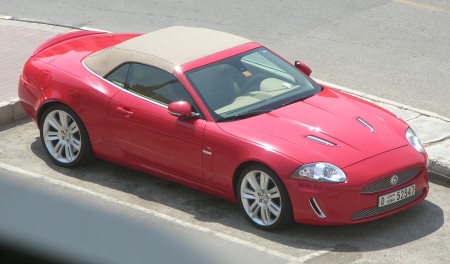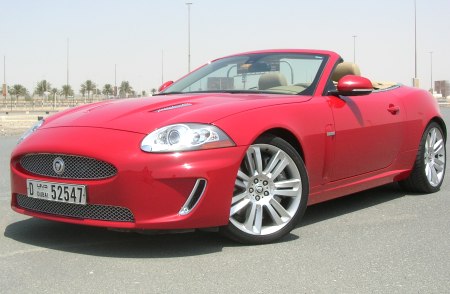So we got a Jaguar XKR convertible

We’ve driven the Jaguar XKR coupe at least twice before, so we expected this car to be familiar to us. But this here is the convertible version of the 2010 Jaguar XKR, which has received a slight facelift, a new gear knob, and a larger 5.0-litre supercharged motor that is ridiculously overpowering on the street.

Even with the facelift, the Jaguar XK retains its “sad baby seal” face, and thereby not nearly as intimidating as most other sports cars.

The front-end facelift involves a reshaped bumper with chrome-lined brake vents and not much else.

We are even more clueless about what was changed in the rear. Maybe the light clusters are new, and the exhaust tips seem somehow larger.

It is not a bad-looking car even with the roof up. Even though the aim of the XKR was never to be a hardcore racer, the roofline is almost as low as that of much smaller sports cars.

The roof itself is nicely lined and padded, enough to give the feeling of being inside a coupe, except that outside noise creeps in very noticeably.

The closing and opening of the roof is a ballet of mechanical pieces. Incidentally, there was what looked like a pigeon-poop stain on the tan roof. Maintaining a roof of this colour can be hard work in the long run.

As the top gets stowed away, the pop-up roll hoops are visible, as are a myriad of wires and cables, some held together with just tape.

The leather dashboard remains familiar. Our previous tester had an aluminium finish, while this one has the optional wooden trim. The LCD computer has a straightforward touchscreen.

The real change is the replacement of the traditional automatic gear-shifter with the rotary knob that has become a Jaguar trademark. That checkered-flag button on the left activates the “dynamic” mode, which enabled us to pull off some fast acceleration times on our first attempt itself, without turning off the stability control and risking a spin-out on public roads.

The front seats are nicely-bolstered, and now come with a weird pattern along the sides.

There isn’t much in the way of back-seat space.

The luggage area is only suitable of a handful of groceries, even with the roof up. That huge fire-extinguisher, the foldaway wind-blocker and the full-size spare tyre all take up a lot of room.

If you are wondering why the driver’s headrest is left that high in all the pictures, it’s because we got the car that way. The headrest is stuck and refuses to come down. That’s the only quality problem we’ve found, other than excessively-worn rubber on the door sills in a test car that has 13,000 km on the clock.

As for the drive, the newly-upgraded XKR now seems to have a bit too much power for this chassis. It has more juice than either the Nissan GT-R or the Corvette ZO6, but it still drives like a grand tourer rather than a true sports car. Maybe Jaguar intended it to be that way.

Comments
Faisal
Do you still have it?? 😀
BJD (Boris)
fire extinguisher in the trunk. thts new. does it help in anyway though?
Rhymes
looks like maserati from front, awesome love it
Murf
A class act! But something is missing..i can’t seem to point what..
azz
after a test drive only i can tell u how it performs. hehe
d.r
I wonder who’d have the time to open the boot and fish out that extinguisher in case the car caught fire. Would’ve been more practical to have it under the passenger seat, like the Land Cruiser.
habiba
nor its not nice it looks old
not my type of car
PHB
Fire extinguisher in trunk makes perfect sense on a road car. If your own car catches fire the only thing you are going to be doing is getting out of it as fast as possible. The extinguisher in the trunk would be for going to help someone else, or possibly to deal with an engine fire.